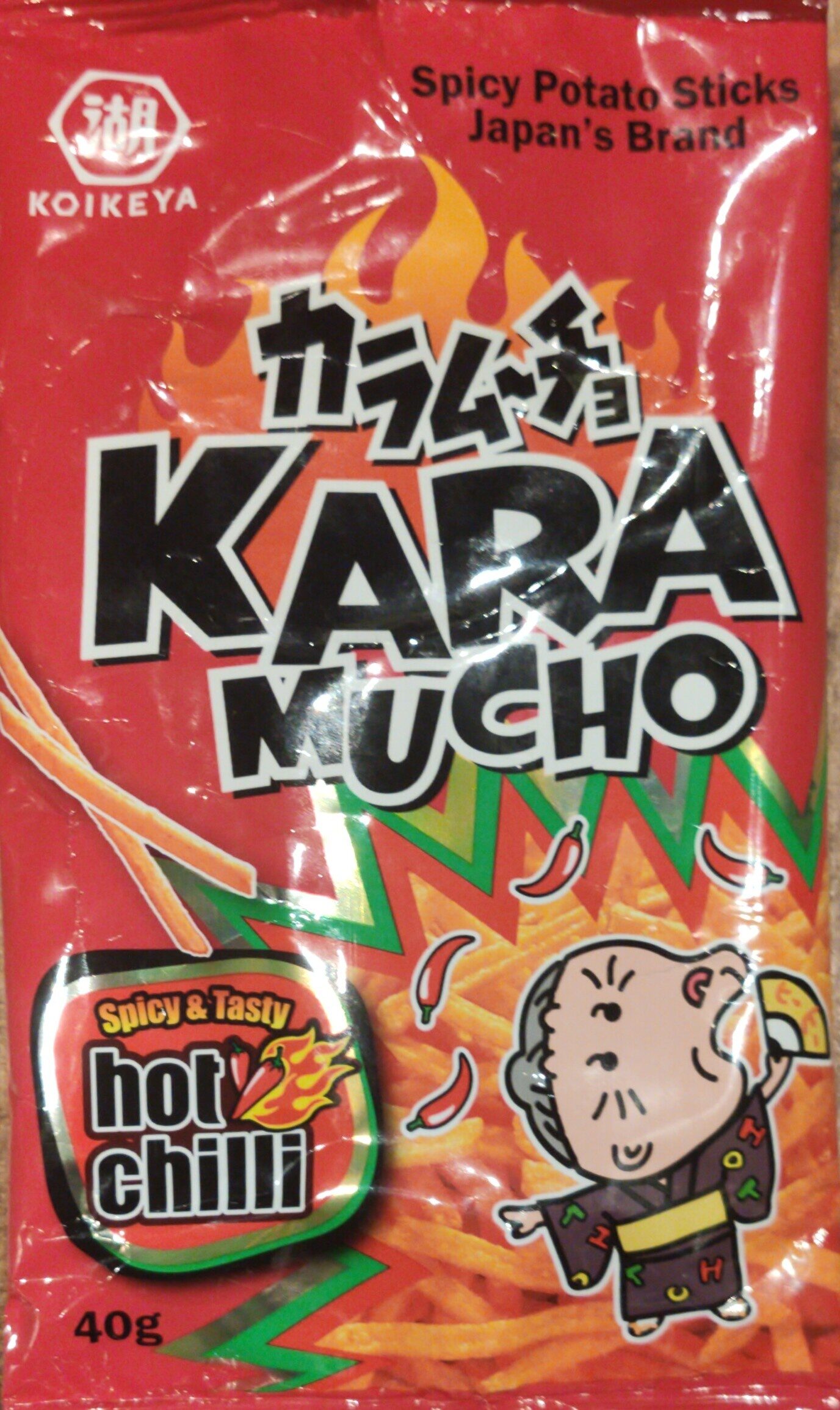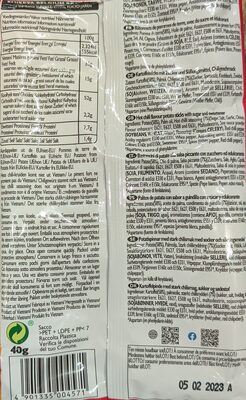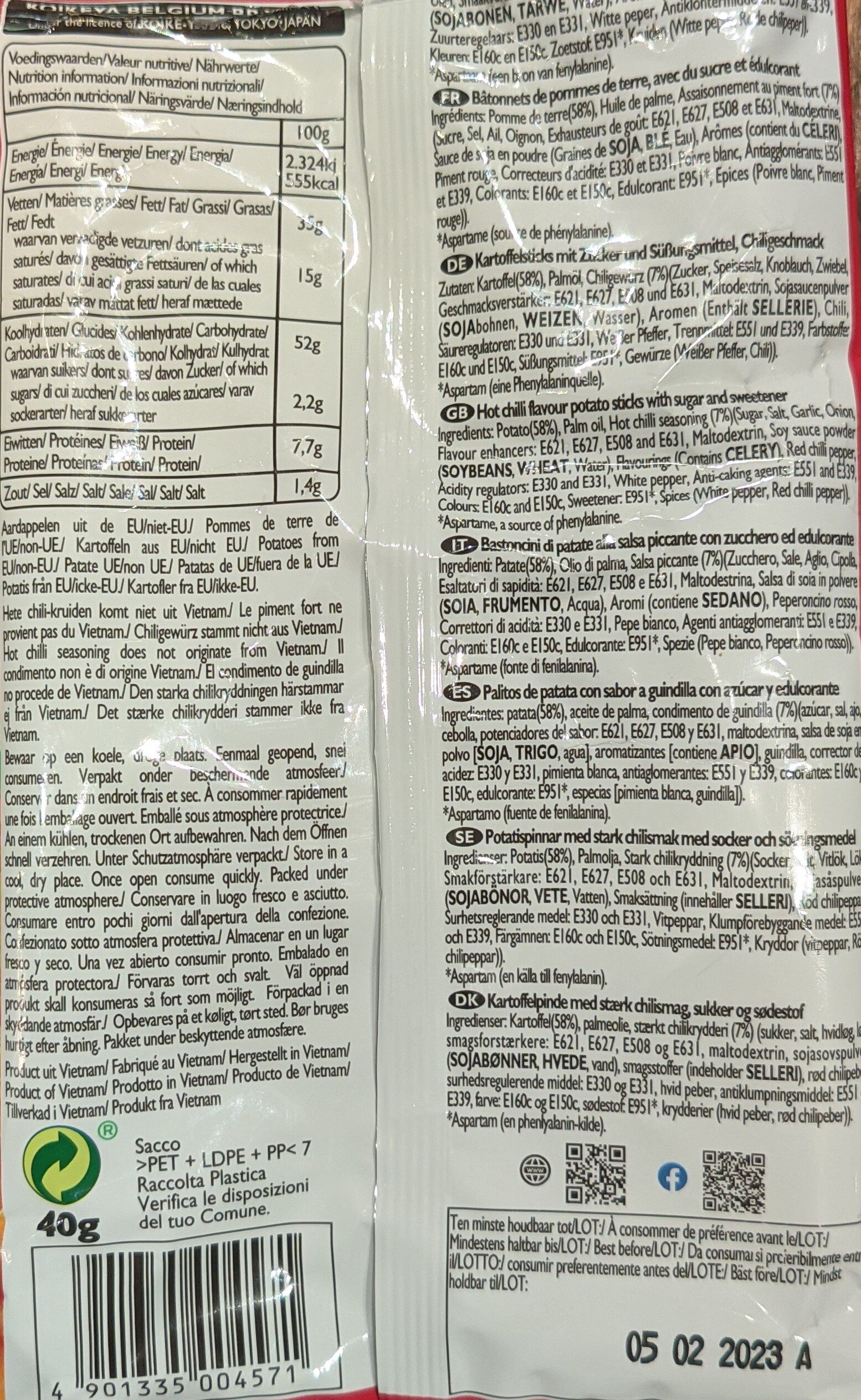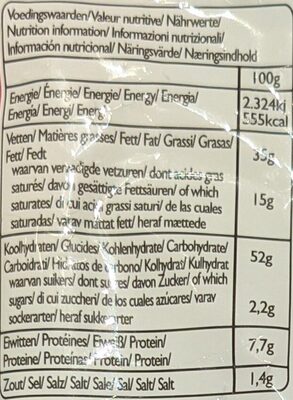Help us make food transparency the norm!
As a non-profit organization, we depend on your donations to continue informing consumers around the world about what they eat.
The food revolution starts with you!
Kara Mucho Spicy Potato Sticks - Koikeya - 40 g
Kara Mucho Spicy Potato Sticks - Koikeya - 40 g
This product page is not complete. You can help to complete it by editing it and adding more data from the photos we have, or by taking more photos using the app for Android or iPhone/iPad. Thank you!
×
Barcode: 4901335004571 (EAN / EAN-13)
Quantity: 40 g
Packaging: es:PET + LDPE + PP< 7
Brands: Koikeya
Categories: Plant-based foods and beverages, Plant-based foods, Snacks, Cereals and potatoes, Salty snacks, Appetizers, Chips and fries, Crisps, Potato crisps, Flavoured potato crisps
Origin of ingredients: Non European Union
Countries where sold: Belgium
Matching with your preferences
Health
Ingredients
-
34 ingredients
: Patata(58%), aceite de palma, condimento de guindila (7%)(azúcar, sal, ajo, cebolla, potenciadores del sabor. E621, E627, E508 y E631, maltodextrina, salsa de soja en polvo [SOJA, TRIGO, agua], aromatizantes [contiene APIO), guindilla, corrector de acidez: E330 y E331, pimienta blanca, antiaglomerantes: E551 y E339, colorantes: E160c y E150c, edulcorante: E951 (Aspartamo), especias [pimienta blanca, guindilla]).Allergens: Celery, Gluten, Soybeans
Food processing
-
Ultra processed foods
Elements that indicate the product is in the 4 - Ultra processed food and drink products group:
- Additive: E150c - Ammonia caramel
- Additive: E160c - Paprika extract
- Additive: E551 - Silicon dioxide
- Additive: E621 - Monosodium glutamate
- Additive: E627 - Disodium guanylate
- Additive: E631 - Disodium inosinate
- Additive: E951 - Aspartame
- Ingredient: Colour
- Ingredient: Flavour enhancer
- Ingredient: Maltodextrin
- Ingredient: Sweetener
Food products are classified into 4 groups according to their degree of processing:
- Unprocessed or minimally processed foods
- Processed culinary ingredients
- Processed foods
- Ultra processed foods
The determination of the group is based on the category of the product and on the ingredients it contains.
Additives
-
E330 - Citric acid
Citric acid is a natural organic acid found in citrus fruits such as lemons, oranges, and limes.
It is widely used in the food industry as a flavor enhancer, acidulant, and preservative due to its tart and refreshing taste.
Citric acid is safe for consumption when used in moderation and is considered a generally recognized as safe (GRAS) food additive by regulatory agencies worldwide.
-
E331 - Sodium citrates
Sodium citrate: Sodium citrate may refer to any of the sodium salts of citrate -though most commonly the third-: Monosodium citrate Disodium citrate Trisodium citrateThe three forms of the salt are collectively known by the E number E331. Sodium citrates are used as acidity regulators in food and drinks, and also as emulsifiers for oils. They enable cheeses to melt without becoming greasy.Source: Wikipedia
-
E339 - Sodium phosphates
Sodium phosphates: Sodium phosphate is a generic term for a variety of salts of sodium -Na+- and phosphate -PO43−-. Phosphate also forms families or condensed anions including di-, tri-, tetra-, and polyphosphates. Most of these salts are known in both anhydrous -water-free- and hydrated forms. The hydrates are more common than the anhydrous forms.Source: Wikipedia
-
E508 - Potassium chloride
Potassium chloride: Potassium chloride -KCl- is a metal halide salt composed of potassium and chlorine. It is odorless and has a white or colorless vitreous crystal appearance. The solid dissolves readily in water and its solutions have a salt-like taste. KCl is used as a fertilizer, in medicine, in scientific applications, and in food processing. In a few states of the United States it is used to cause cardiac arrest as the third drug in the "three drug cocktail" for executions by lethal injection. It occurs naturally as the mineral sylvite, and in combination with sodium chloride as sylvinite.The version for injection is on the World Health Organization's List of Essential Medicines, the most important medications needed in a basic health system.Source: Wikipedia
-
E551 - Silicon dioxide
Silicon dioxide: Silicon dioxide, also known as silica, silicic acid or silicic acid anydride is an oxide of silicon with the chemical formula SiO2, most commonly found in nature as quartz and in various living organisms. In many parts of the world, silica is the major constituent of sand. Silica is one of the most complex and most abundant families of materials, existing as a compound of several minerals and as synthetic product. Notable examples include fused quartz, fumed silica, silica gel, and aerogels. It is used in structural materials, microelectronics -as an electrical insulator-, and as components in the food and pharmaceutical industries. Inhaling finely divided crystalline silica is toxic and can lead to severe inflammation of the lung tissue, silicosis, bronchitis, lung cancer, and systemic autoimmune diseases, such as lupus and rheumatoid arthritis. Uptake of amorphous silicon dioxide, in high doses, leads to non-permanent short-term inflammation, where all effects heal.Source: Wikipedia
-
E621 - Monosodium glutamate
Monosodium glutamate: Monosodium glutamate -MSG, also known as sodium glutamate- is the sodium salt of glutamic acid, one of the most abundant naturally occurring non-essential amino acids. Glutamic acid is found naturally in tomatoes, grapes, cheese, mushrooms and other foods.MSG is used in the food industry as a flavor enhancer with an umami taste that intensifies the meaty, savory flavor of food, as naturally occurring glutamate does in foods such as stews and meat soups. It was first prepared in 1908 by Japanese biochemist Kikunae Ikeda, who was trying to isolate and duplicate the savory taste of kombu, an edible seaweed used as a base for many Japanese soups. MSG as a flavor enhancer balances, blends, and rounds the perception of other tastes.The U.S. Food and Drug Administration has given MSG its generally recognized as safe -GRAS- designation. A popular belief is that large doses of MSG can cause headaches and other feelings of discomfort, known as "Chinese restaurant syndrome," but double-blind tests fail to find evidence of such a reaction. The European Union classifies it as a food additive permitted in certain foods and subject to quantitative limits. MSG has the HS code 29224220 and the E number E621.Source: Wikipedia
-
E627 - Disodium guanylate
Disodium guanylate: Disodium guanylate, also known as sodium 5'-guanylate and disodium 5'-guanylate, is a natural sodium salt of the flavor enhancing nucleotide guanosine monophosphate -GMP-. Disodium guanylate is a food additive with the E number E627. It is commonly used in conjunction with glutamic acid. As it is a fairly expensive additive, it is not used independently of glutamic acid; if disodium guanylate is present in a list of ingredients but MSG does not appear to be, it is likely that glutamic acid is provided as part of another ingredient such as a processed soy protein complex. It is often added to foods in conjunction with disodium inosinate; the combination is known as disodium 5'-ribonucleotides. Disodium guanylate is produced from dried seaweed and is often added to instant noodles, potato chips and other snacks, savory rice, tinned vegetables, cured meats, and packaged soup.Source: Wikipedia
-
E631 - Disodium inosinate
Disodium inosinate: Disodium inosinate -E631- is the disodium salt of inosinic acid with the chemical formula C10H11N4Na2O8P. It is used as a food additive and often found in instant noodles, potato chips, and a variety of other snacks. Although it can be obtained from bacterial fermentation of sugars, it is often commercially prepared from animal sources.Source: Wikipedia
-
E951 - Aspartame
Aspartame: Aspartame -APM- is an artificial non-saccharide sweetener used as a sugar substitute in some foods and beverages. In the European Union, it is codified as E951. Aspartame is a methyl ester of the aspartic acid/phenylalanine dipeptide. A panel of experts set up by the European Food Safety Authority concluded in 2013 that aspartame is safe for human consumption at current levels of exposure. As of 2018, evidence does not support a long-term benefit for weight loss or in diabetes. Because its breakdown products include phenylalanine, people with the genetic condition phenylketonuria -PKU- must be aware of this as an additional source.It was first sold under the brand name NutraSweet. It was first made in 1965, and the patent expired in 1992. It was initially approved for use in food products by the U.S. Food and Drug Administration -FDA- in 1981. The safety of aspartame has been the subject of several political and medical controversies, United States congressional hearings, and Internet hoaxes.Source: Wikipedia
Ingredients analysis
-
Palm oil
Ingredients that contain palm oil: Palm oil
-
Vegan status unknown
Unrecognized ingredients: es:condimento-de-guindilaSome ingredients could not be recognized.
We need your help!
You can help us recognize more ingredients and better analyze the list of ingredients for this product and others:
- Edit this product page to correct spelling mistakes in the ingredients list, and/or to remove ingredients in other languages and sentences that are not related to the ingredients.
- Add new entries, synonyms or translations to our multilingual lists of ingredients, ingredient processing methods, and labels.
If you would like to help, join the #ingredients channel on our Slack discussion space and/or learn about ingredients analysis on our wiki. Thank you!
-
Vegetarian status unknown
Unrecognized ingredients: es:condimento-de-guindilaSome ingredients could not be recognized.
We need your help!
You can help us recognize more ingredients and better analyze the list of ingredients for this product and others:
- Edit this product page to correct spelling mistakes in the ingredients list, and/or to remove ingredients in other languages and sentences that are not related to the ingredients.
- Add new entries, synonyms or translations to our multilingual lists of ingredients, ingredient processing methods, and labels.
If you would like to help, join the #ingredients channel on our Slack discussion space and/or learn about ingredients analysis on our wiki. Thank you!
-
Details of the analysis of the ingredients
We need your help!
Some ingredients could not be recognized.
We need your help!
You can help us recognize more ingredients and better analyze the list of ingredients for this product and others:
- Edit this product page to correct spelling mistakes in the ingredients list, and/or to remove ingredients in other languages and sentences that are not related to the ingredients.
- Add new entries, synonyms or translations to our multilingual lists of ingredients, ingredient processing methods, and labels.
If you would like to help, join the #ingredients channel on our Slack discussion space and/or learn about ingredients analysis on our wiki. Thank you!
: Patata 58%, aceite de palma, condimento de guindila 7% (azúcar, sal, ajo, cebolla, potenciadores del sabor, e621, e627, e508, e631, maltodextrina, salsa de soja (SOJA, TRIGO, agua)), guindilla, corrector de acidez (e330), e331, pimienta blanca, antiaglomerantes (e551), e339, colorantes (e160c), e150c, edulcorante (e951 (Aspartamo)), especias (pimienta blanca, guindilla)- Patata -> en:potato - vegan: yes - vegetarian: yes - ciqual_food_code: 4003 - percent_min: 58 - percent: 58 - percent_max: 58
- aceite de palma -> en:palm-oil - vegan: yes - vegetarian: yes - from_palm_oil: yes - ciqual_food_code: 16129 - percent_min: 7 - percent_max: 35
- condimento de guindila -> es:condimento-de-guindila - percent_min: 7 - percent: 7 - percent_max: 7
- azúcar -> en:sugar - vegan: yes - vegetarian: yes - ciqual_proxy_food_code: 31016 - percent_min: 0.636363636363636 - percent_max: 2.2
- sal -> en:salt - vegan: yes - vegetarian: yes - ciqual_food_code: 11058 - percent_min: 0.48 - percent_max: 1.4
- ajo -> en:garlic - vegan: yes - vegetarian: yes - ciqual_food_code: 11000 - percent_min: 0.377777777777778 - percent_max: 1.4
- cebolla -> en:onion - vegan: yes - vegetarian: yes - ciqual_food_code: 20034 - percent_min: 0.25 - percent_max: 1.4
- potenciadores del sabor -> en:flavour-enhancer - percent_min: 0 - percent_max: 1.4
- e621 -> en:e621 - vegan: yes - vegetarian: yes - percent_min: 0 - percent_max: 1.16666666666667
- e627 -> en:e627 - vegan: maybe - vegetarian: maybe - percent_min: 0 - percent_max: 1
- e508 -> en:e508 - vegan: yes - vegetarian: yes - percent_min: 0 - percent_max: 0.938939393939394
- e631 -> en:e631 - vegan: maybe - vegetarian: maybe - percent_min: 0 - percent_max: 0.804805194805195
- maltodextrina -> en:maltodextrin - vegan: yes - vegetarian: yes - percent_min: 0 - percent_max: 0.704204545454546
- salsa de soja -> en:soy-sauce - vegan: maybe - vegetarian: maybe - ciqual_food_code: 11104 - percent_min: 0 - percent_max: 0.625959595959596
- SOJA -> en:soya - vegan: yes - vegetarian: yes - percent_min: 0 - percent_max: 0.625959595959596
- TRIGO -> en:wheat - vegan: yes - vegetarian: yes - ciqual_proxy_food_code: 9410 - percent_min: 0 - percent_max: 0.312979797979798
- agua -> en:water - vegan: yes - vegetarian: yes - ciqual_food_code: 18066 - percent_min: 0 - percent_max: 0.208653198653199
- guindilla -> en:chili-pepper - vegan: yes - vegetarian: yes - ciqual_food_code: 20151 - percent_min: 0 - percent_max: 7
- corrector de acidez -> en:acidity-regulator - percent_min: 0 - percent_max: 7
- e330 -> en:e330 - vegan: yes - vegetarian: yes - percent_min: 0 - percent_max: 7
- e331 -> en:e331 - vegan: yes - vegetarian: yes - percent_min: 0 - percent_max: 7
- pimienta blanca -> en:white-pepper - vegan: yes - vegetarian: yes - ciqual_food_code: 11019 - percent_min: 0 - percent_max: 7
- antiaglomerantes -> en:anti-caking-agent - percent_min: 0 - percent_max: 5.83333333333333
- e551 -> en:e551 - vegan: yes - vegetarian: yes - percent_min: 0 - percent_max: 5.83333333333333
- e339 -> en:e339 - vegan: yes - vegetarian: yes - percent_min: 0 - percent_max: 5
- colorantes -> en:colour - percent_min: 0 - percent_max: 4.375
- e160c -> en:e160c - vegan: yes - vegetarian: yes - percent_min: 0 - percent_max: 4.375
- e150c -> en:e150a - vegan: yes - vegetarian: yes - percent_min: 0 - percent_max: 3.88888888888889
- edulcorante -> en:sweetener - percent_min: 0 - percent_max: 3.5
- e951 -> en:e951 - vegan: yes - vegetarian: yes - percent_min: 0 - percent_max: 3.5
- Aspartamo -> en:e951 - vegan: yes - vegetarian: yes - percent_min: 0 - percent_max: 3.5
- e951 -> en:e951 - vegan: yes - vegetarian: yes - percent_min: 0 - percent_max: 3.5
- especias -> en:spice - vegan: yes - vegetarian: yes - percent_min: 0 - percent_max: 3.18181818181818
- pimienta blanca -> en:white-pepper - vegan: yes - vegetarian: yes - ciqual_food_code: 11019 - percent_min: 0 - percent_max: 3.18181818181818
- guindilla -> en:chili-pepper - vegan: yes - vegetarian: yes - ciqual_food_code: 20151 - percent_min: 0 - percent_max: 1.59090909090909
Nutrition
-
Bad nutritional quality
⚠ ️Warning: the amount of fiber is not specified, their possible positive contribution to the grade could not be taken into account.This product is not considered a beverage for the calculation of the Nutri-Score.
Positive points: 0
- Proteins: 4 / 5 (value: 7.7, rounded value: 7.7)
- Fiber: 0 / 5 (value: 0, rounded value: 0)
- Fruits, vegetables, nuts, and colza/walnut/olive oils: 0 / 5 (value: 0, rounded value: 0)
Negative points: 22
- Energy: 6 / 10 (value: 2322, rounded value: 2322)
- Sugars: 0 / 10 (value: 2.2, rounded value: 2.2)
- Saturated fat: 10 / 10 (value: 15, rounded value: 15)
- Sodium: 6 / 10 (value: 560, rounded value: 560)
The points for proteins are not counted because the negative points are greater or equal to 11.
Nutritional score: (22 - 0)
Nutri-Score:
-
Nutrient levels
-
Fat in high quantity (35%)
What you need to know- A high consumption of fat, especially saturated fats, can raise cholesterol, which increases the risk of heart diseases.
Recommendation: Limit the consumption of fat and saturated fat- Choose products with lower fat and saturated fat content.
-
Saturated fat in high quantity (15%)
What you need to know- A high consumption of fat, especially saturated fats, can raise cholesterol, which increases the risk of heart diseases.
Recommendation: Limit the consumption of fat and saturated fat- Choose products with lower fat and saturated fat content.
-
Sugars in low quantity (2.2%)
What you need to know- A high consumption of sugar can cause weight gain and tooth decay. It also augments the risk of type 2 diabetes and cardio-vascular diseases.
Recommendation: Limit the consumption of sugar and sugary drinks- Sugary drinks (such as sodas, fruit beverages, and fruit juices and nectars) should be limited as much as possible (no more than 1 glass a day).
- Choose products with lower sugar content and reduce the consumption of products with added sugars.
-
Salt in moderate quantity (1.4%)
What you need to know- A high consumption of salt (or sodium) can cause raised blood pressure, which can increase the risk of heart disease and stroke.
- Many people who have high blood pressure do not know it, as there are often no symptoms.
- Most people consume too much salt (on average 9 to 12 grams per day), around twice the recommended maximum level of intake.
Recommendation: Limit the consumption of salt and salted food- Reduce the quantity of salt used when cooking, and don't salt again at the table.
- Limit the consumption of salty snacks and choose products with lower salt content.
-
-
Nutrition facts
Nutrition facts As sold
for 100 g / 100 mlAs sold
per serving (40 g)Compared to: Flavoured potato crisps Energy 2,322 kj
(555 kcal)929 kj
(222 kcal)+7% Fat 35 g 14 g +14% Saturated fat 15 g 6 g +375% Carbohydrates 52 g 20.8 g -2% Sugars 2.2 g 0.88 g -13% Fiber ? ? Proteins 7.7 g 3.08 g +28% Salt 1.4 g 0.56 g -3% Fruits‚ vegetables‚ nuts and rapeseed‚ walnut and olive oils (estimate from ingredients list analysis) 5.241 % 5.241 %
Environment
-
Eco-Score B - Low environmental impact
⚠ ️Select a country in order to include the full impact of transportation.The Eco-Score is an experimental score that summarizes the environmental impacts of food products.→ The Eco-Score was initially developped for France and it is being extended to other European countries. The Eco-Score formula is subject to change as it is regularly improved to make it more precise and better suited to each country.Life cycle analysis
-
Average impact of products of the same category: A (Score: 87/100)
Category: Potato crisps
Category: Potato crisps
- PEF environmental score: 0.22 (the lower the score, the lower the impact)
- including impact on climate change: 1.54 kg CO2 eq/kg of product
Stage Impact Agriculture
62.8 %Processing
17.3 %Packaging
10.6 %Transportation
7.1 %Distribution
2.2 %Consumption
0.0 %
Bonuses and maluses
-
Missing origins of ingredients information
Malus: -5
⚠ ️ The origins of the ingredients of this product are not indicated.
If they are indicated on the packaging, you can modify the product sheet and add them.
If you are the manufacturer of this product, you can send us the information with our free platform for producers.
-
Ingredients that threatens species
Malus: -10
Contains palm oil
Tropical forests in Asia, Africa and Latin America are destroyed to create and expand oil palm tree plantations. The deforestation contributes to climate change, and it endangers species such as the orangutan, the pigmy elephant and the Sumatran rhino.
-
Packaging with a medium impact
Malus: -8
Shape Material Recycling Impact Unknown LDPE 4 - Low-density polyethylene High ⚠ ️ The information about the packaging of this product is not sufficiently precise (exact shapes and materials of all components of the packaging).⚠ ️ For a more precise calculation of the Eco-Score, you can modify the product page and add them.
If you are the manufacturer of this product, you can send us the information with our free platform for producers.
Eco-Score for this product
-
Impact for this product: B (Score: 64/100)
Product: Kara Mucho Spicy Potato Sticks - Koikeya - 40 g
Life cycle analysis score: 87
Sum of bonuses and maluses: -23
Final score: 64/100
-
Carbon footprint
-
Equal to driving 0.8 km in a petrol car
154 g CO² per 100g of product
The carbon emission figure comes from ADEME's Agribalyse database, for the category: Potato crisps (Source: ADEME Agribalyse Database)
Stage Impact Agriculture
53.5 %Processing
15.0 %Packaging
18.2 %Transportation
11.9 %Distribution
1.3 %Consumption
0.0 %
Packaging
-
Packaging with a medium impact
-
Packaging parts
(LDPE 4 - Low-density polyethylene)
-
Packaging materials
Material % Packaging weight Packaging weight per 100 g of product Plastic
-
Transportation
-
Origins of ingredients
Missing origins of ingredients information
⚠ ️ The origins of the ingredients of this product are not indicated.
If they are indicated on the packaging, you can modify the product sheet and add them.
If you are the manufacturer of this product, you can send us the information with our free platform for producers.Add the origins of ingredients for this product Add the origins of ingredients for this product
Threatened species
-
Contains palm oil
Drives deforestation and threatens species such as the orangutan
Tropical forests in Asia, Africa and Latin America are destroyed to create and expand oil palm tree plantations. The deforestation contributes to climate change, and it endangers species such as the orangutan, the pigmy elephant and the Sumatran rhino.
Report a problem
-
Incomplete or incorrect information?
Category, labels, ingredients, allergens, nutritional information, photos etc.
If the information does not match the information on the packaging, please complete or correct it. Open Food Facts is a collaborative database, and every contribution is useful for all.
Data sources
Product added on by kiliweb
Last edit of product page on by duhowpi.
Product page also edited by yuka.sY2b0xO6T85zoF3NwEKvlk8XXf39nWv4MATVm2-m-_LWFoDPRNFL7Yj8Das.











